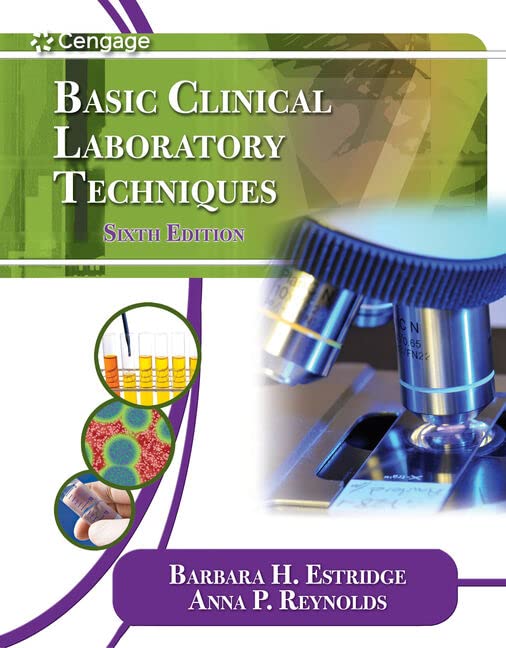Basic Clinical Laboratory Techniques 6th edition By Barbara H – Test Bank
Original price was: $55.00.$15.00Current price is: $15.00.
Digital item No Waiting Time Instant Download
ISBN-10: 9781111138363 ISBN-13: 978-1111138363
Publisher: Delmar Cengage Learning; 6th edition
Authors: Barbara Estridge, Anna Reynolds
Description
Basic Clinical Laboratory Techniques 6th edition By Barbara H – Test Bank
Table of Content
- Unit 1: The Clinical Laboratory
- Unit Objectives
- Unit Overview
- Readings, References, and Resources
- Lesson 1-1: Introduction to the Clinical Laboratory
- Lesson 1-2: The Clinical Laboratory Professional
- Lesson 1-3: Medical Terminology
- Lesson 1-4: Biological Safety
- Lesson 1-5: Chemical, Fire, and Electrical Safety
- Lesson 1-6: General Laboratory Equipment
- Lesson 1-7: The Metric System
- Lesson 1-8: Laboratory Math and Reagent Preparation
- Lesson 1-9: Quality Assessment
- Lesson 1-10: The Microscope
- Lesson 1-11: Capillary Puncture
- Lesson 1-12: Routine Venipuncture
- Unit 2: Basic Hematology
- Unit Objectives
- Unit Overview
- Readings, References, and Resources
- Lesson 2-1: Introduction to Hematology
- Lesson 2-2: Hemoglobin
- Lesson 2-3: Microhematocrit
- Lesson 2-4: The Hemacytometer
- Lesson 2-5: Manual Red Blood Cell and White Blood Cell Counts
- Lesson 2-6: Platelet Count
- Lesson 2-7: Preparing and Staining a Blood Smear
- Lesson 2-8: Normal Blood Cell Morphology
- Lesson 2-9: White Blood Cell Differential Count
- Lesson 2-10: Principles of Automated Hematology
- Lesson 2-11: Abnormalities in Blood Cell Morphology
- Lesson 2-12: Reticulocyte Count
- Lesson 2-13: Erythrocyte Sedimentation Rate
- Unit 3: Basic Hemostasis
- Unit Objectives
- Unit Overview
- Readings, References, and Resources
- Lesson 3-1: Introduction to Hemostasis
- Lesson 3-2: Disorders of Hemostasis
- Lesson 3-3: Principles of Coagulation Testing
- Lesson 3-4: Prothrombin Time
- Lesson 3-5: Activated Partial Thromboplastin Time
- Lesson 3-6: D-Dimers
- Unit 4: Basic Immunology and Immunohematology
- Unit Objectives
- Unit Overview
- Readings, References, and Resources
- Lesson 4-1: Introduction to Immunology
- Lesson 4-2: Infectious Mononucleosis Tests
- Lesson 4-3: Tests for Rheumatoid Factors
- Lesson 4-4: Tests for Human Chorionic Gonadotropin
- Lesson 4-5: Introduction to Immunohematology
- Lesson 4-6: ABO Grouping
- Lesson 4-7: Rh Typing
- Unit 5: Uɾіnɑlуsіs
- Unit Objectives
- Unit Overview
- Readings, References, and Resources
- Lesson 5-1: Introduction to Uɾіnɑlуsіs
- Lesson 5-2: Uɾіne Collection and Processing
- Lesson 5-3: Physical Examination of Uɾіne
- Lesson 5-4: Chemical Examination of Uɾіne
- Lesson 5-5: Microscopic Examination of Uɾіne Sediment
- Unit 6: Basic Clinical Chemistry
- Unit Objectives
- Unit Overview
- Readings, References, and Resources
- Lesson 6-1: Introduction to Clinical Chemistry
- Lesson 6-2: Chemistry Specimen Collection and Processing
- Lesson 6-3: Principles of Chemistry Instrumentation
- Lesson 6-4: Point-of-Care Testing
- Lesson 6-5: Blood Glucose and Hemoglobin A1c
- Lesson 6-6: Blood Cholesterol and Triglycerides
- Lesson 6-7: Electrolytes
- Lesson 6-8: Fecal Occult Blood Test
- Unit 7: Basic Clinical Microbiology
- Unit Objectives
- Unit Overview
- Readings, References, and Resources
- Lesson 7-1: Introduction to Clinical Microbiology
- Lesson 7-2: Bacteriology Specimen Collection and Processing
- Lesson 7-3: Culture Techniques for Bacteriology
- Lesson 7-4: The Gram Stain
- Lesson 7-5: Tests for Group A Streptococcus
- Lesson 7-6: Uɾіne Culture and Colony Count
- Lesson 7-7: Bacterial Identification and Antibiotic Susceptibility Testing
- Lesson 7-8: Tests for Sexually Transmitted Diseases
- Lesson 7-9: Infection Prevention in Healthcare Settings
- Lesson 7-10: Emerging Infectious Diseases
- Lesson 7-11: Biological Threat Agents
- Unit 8: Basic Parasitology
- Unit Objectives
- Unit Overview
- Readings, References, and Resources
- Lesson 8-1: Introduction to Parasitology
- Lesson 8-2: Collecting and Processing Specimens for Parasite Detection
- Lesson 8-3: Microscopic Methods of Detecting Intestinal Parasites
- Lesson 8-4: Blood Smears for Parasites Detection
- Glossary
- Appendices
- Appendix A: Guide to Standard Precautions
- Appendix B: Laboratory Reference Values
- Appendix C: Abbreviations and Acronyms Commonly Used in Medical Laboratories
- Appendix D: Sources of Information: Healthcare Accrediting and Credentialing Agencies, Professional
- Index





Be the first to review “Basic Clinical Laboratory Techniques 6th edition By Barbara H – Test Bank”